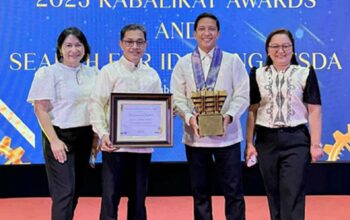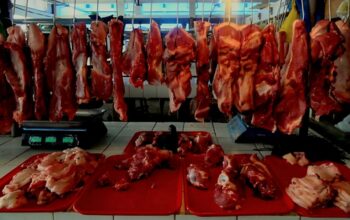
HE worked most of his adult life in a plant, now that he is retired, his work is still with plants, one that has visibly kept his energy even at 60.
No, it is not that coffee that keeps him awake and athletic, a rarity among retirees whose lifestyle in the metropolis picture them as hunched cane bearing elders.
Meet Eric John Sese, a mechanical engineer by profession, retired, born, raised and schooled in Manila, and even talks like your exclusive schooled but street-smart Manileno.
It was only when he met and married a physician who was working her residency at the Philippine General Hospital that he found himself in a new home, in Zamboanga.
Working then at the National Power Corporation overseeing its power plants spread all over the country, Eric, who has described himself as makulit, meticulously observant and a voracious reader did see most of the country and thinks of farming as a retirement pastime.
Since then, possibly due to the innate sense of mechanical engineers to understand the principles and understand it all, he has set his scopes on organic farming, not the one most organic farms spend fortunes to be called organic.
For one, how could he ever grow the country’s top tasting and highly rated green Robusta beans when his farm in Candumayao is just 200 meters above sea level.
A coffee, to be truly decent to be rated fine and not just premium or commercial, should be grown on higher elevations. Grown from the Visayas, his highly rated robusta, is indeed quite a feat.
The best tasting coffee are Arabicas and Robustas.
Arabicas are grown in the high lands, and coffees grown in colder climates, take more time to ripen, and in that time, imbibe all the pleasant sweet tastes.
Meanwhile, Robusta, Arabica’s witty little brother, is often grown in the lowlands would have shorter time to mature into cherry ripe ready to harvest beans, and thus the bitter tasting, creamier caffeinated dose one seeks as an upper.
For Eric, whose 16.7 hectare farm in lowland Candumayao, shouldn’t fare well, against the arabicas in the Cordilleras or Region 1 and Region 12, he did barge into the circle of the best.
His secret? Organic agriculture. Integrated, diversified. Truly organic.
His farm, which his family acquired in 2012, is blessed with his penchant for bringing in choice fruit tree seedlings from Mindanao.
He also has a collection of endemic dipterocarps from Bohol, dwarf hybrid coconuts and even plants endemic to the country sourced out from Luzon. In fact, he keeps a nursery of endemic trees near his yet unfinished coffee processing building.
“I once bought a fern tree in Quezon City, lugged it to Bohol to have it planted only to realize, andami pala nun dito?,” his amazed sheepish expression showing.
Ever since, he knew he was into farming.
When I was with Napocor, one time I took a leave when I was visiting a power plant in Mindanao, and went to Tagum City to join a (coffee growing and production) training offered in collaboration with Nestle, it was free, he shared.
While his idea and his previous readings would dictate that it would be an organic farm he would start, Nestle technicians were into chemical fertilizer. He was dismayed.
But having bought seedlings, he brought them to his farm in Bohol and, as he planned based on his readings, went fully organic.
Setting up a vermiculture, his first problem was sourcing animal manure.
After a while, he realized, buying a few heads of cattle would let him access manure. Then he told his workers, they could actually pasture their cows or carabaos in the farm for free, he just would have the manure.
He, as mechanical engineer also devised a way to make his own vermi tea, a natural liquid fertilizer from worm castings, and he sources out his pesticides and insecticides from the Department of Agriculture.
He also has stingless bees in the farm, to help in the pollination for increased harvest.
His orchards, now already mature, even when hit by Odette, is staring to recover.
The surrounding fruit trees in the coffee farm could have lent their tastes to the coffee where pollinators also bring in the much needed distinct after tastes.
His purely organic farming practice in his coffee has helped him achieve 1.46 metric tons of fine and premium beans per hectare, another rarity envied by robusta farmers whose best production records only hit .6 metric tons.
During the pandemic, Eric enrolled with UP Los Banos Open university, for Organic Agriculture and finished with high distinction. This helped him bolster his resolve to make his farm truly organic.
Now, Eric, who keeps small coffee bean processing in his kitchen in Candumayao, he is already surviving, although he admits, there is still much to be done.
When his beans won the Philippine Coffee Quality Competition, he modestly said he saw 70% increase in his sales, but that is still not enough.
Now selling his fine and premium beans, which his workers carefully handpick, sort out and dry, his patience and lively approach at life has gotten his beans to be brewed in Manila, Quezon City, Cavite and even as far as Singapore, he said.
Next time you are sipping on that coffee you ordered from your favorite barista, savor that aroma, feel the faint hints of the fruits there, and chances are, those are from Finca de Gabriela.
That name is Latin American for Gabrielas Estate, nurtured by a plant manager, a real plant manager. (RAHC/PIA-7/Bohol)



